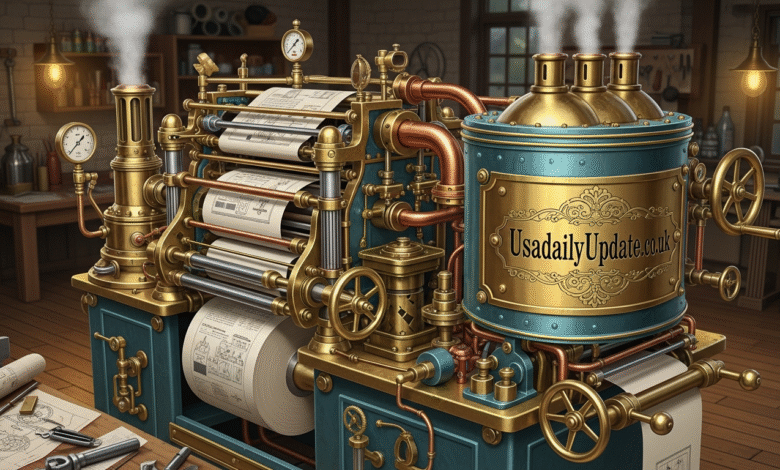Steam Machine: Revolutionary Gaming Failed Experiment

Introduction
Remember when Valve announced they were going to change gaming forever with their own hardware? The Steam Machine was supposed to be the device that brought PC gaming to your living room without compromise. It promised the power of a gaming PC with the simplicity of a console. The gaming community buzzed with excitement as Valve revealed their ambitious plan.
Then something strange happened. The Steam Machine quietly disappeared from conversations, store shelves, and eventually from Valve’s own website. What started as one of the most hyped gaming hardware launches of the decade ended in silence. Most gamers today have never even seen one in person.
If you’re wondering what happened to this revolutionary device, you’re not alone. The story of the Steam Machine involves bold ambitions, technical challenges, confused messaging, and valuable lessons about the gaming hardware market. In this comprehensive guide, you’ll learn what Steam Machines actually were, why Valve believed they would succeed, what went wrong, and whether the concept has any future. We’ll also explore the lasting impact this failed experiment had on gaming and what it taught the industry about hardware innovation.
What Exactly Was a Steam Machine?
Understanding the Steam Machine requires going back to its core concept. Valve didn’t create a single device. Instead, they partnered with various manufacturers to produce a family of gaming PCs designed specifically for living room use. Each ran SteamOS, Valve’s custom Linux based operating system.
The idea was brilliant in theory. You could choose from multiple manufacturers at different price points, just like buying a laptop. Alienware, Dell, and other companies produced their own versions with varying specs and designs. This approach gave consumers options while spreading the development costs across multiple partners.
SteamOS served as the unifying factor across all devices. This operating system was built on Linux and designed exclusively for gaming. It featured a controller friendly interface that looked more like a console dashboard than a traditional computer desktop. You could navigate everything with Valve’s new Steam Controller without needing a keyboard or mouse.
The devices themselves looked different from typical gaming PCs. Most manufacturers designed compact boxes meant to sit in entertainment centers alongside your PlayStation or Xbox. They connected to televisions rather than computer monitors. The goal was making PC gaming accessible in the same space where people already played console games.
Price points varied dramatically across the Steam Machine lineup. Some models cost around $500, competing directly with PlayStation 4 and Xbox One. Others exceeded $1,500 with high end components targeting enthusiast gamers. This range was supposed to appeal to different market segments, but it ended up creating confusion about what a Steam Machine actually offered.
The Vision Behind Valve’s Hardware Experiment
Valve had specific reasons for believing the Steam Machine would revolutionize gaming. Their vision addressed real problems in the gaming landscape at the time. Understanding their logic helps explain why they invested so heavily in this project.
Breaking the Windows Monopoly
Microsoft’s dominance concerned Valve leadership deeply. Windows was essentially mandatory for PC gaming, giving Microsoft enormous leverage. When Microsoft launched the Windows Store and started positioning it as a competitor to Steam, Valve saw an existential threat to their business model.
SteamOS represented Valve’s attempt to create a viable alternative. If enough people adopted Linux based gaming through Steam Machines, Valve could reduce dependence on Microsoft. This strategic goal drove much of the decision making around the project.
The open source nature of Linux also appealed to Valve’s philosophy. Unlike Windows, Linux could be customized completely. Valve had full control over the user experience without needing Microsoft’s permission for changes. This independence was valuable for a company that built its empire on distribution control.
Capturing the Living Room Market
Console gaming generated billions in revenue that PC gaming couldn’t access easily. People who preferred playing on their couches with controllers represented a massive market. Valve wanted to bring these users into the Steam ecosystem without forcing them to sit at desks.
The living room had become a battleground for entertainment dominance. Microsoft, Sony, and Nintendo controlled gaming in that space. Streaming devices like Roku and Apple TV competed for attention. Valve believed a device that combined all these functions under their platform could carve out significant market share.
The Steam Machine offered something consoles couldn’t match directly. Upgradability, backwards compatibility, and access to Steam’s massive library gave it theoretical advantages. You wouldn’t need to replace the entire device every generation like consoles required. Just swap out components as needed.
The Steam Controller Innovation
Valve developed the Steam Controller specifically for this initiative. This unique controller featured trackpads instead of traditional analog sticks on the right side. The design aimed to make PC games controllable without keyboard and mouse while maintaining precision.
The controller’s customization options were unprecedented. You could map any input to any button and save configurations per game. Community shared configurations meant you could benefit from other players’ optimization work. For games never designed with controllers in mind, this flexibility was supposed to be revolutionary.
Haptic feedback in the trackpads provided physical responses that guided your thumb positioning. The gyroscope allowed motion controls for aiming precision. These features combined to create what Valve believed was the ideal input device for all gaming scenarios. The Steam Controller launched alongside Steam Machines as an integrated part of the ecosystem.

Why Steam Machines Failed to Gain Traction
The gap between vision and reality proved too large for Steam Machines to overcome. Multiple factors contributed to their commercial failure and eventual discontinuation. Each problem compounded the others until the entire initiative collapsed.
The Linux Gaming Library Problem
SteamOS ran on Linux, which immediately limited game compatibility. When Steam Machines launched in 2015, only about 1,500 Steam games supported Linux. This sounds impressive until you realize Steam offered over 6,000 games at the time. Major releases frequently skipped Linux entirely.
Gamers noticed immediately that many popular titles simply wouldn’t run on their Steam Machine. Big franchises like Grand Theft Auto V, The Witcher 3, and Fallout 4 weren’t available. Publishers saw little reason to invest in Linux ports when the user base was tiny. This created a vicious cycle where small library led to low sales, which discouraged more Linux development.
You could technically install Windows on most Steam Machines to access the full library. However, this defeated the entire purpose of the device. It also voided some warranties and created setup complexity that contradicted the plug and play vision. Most users interested enough to install Windows would just build a regular gaming PC.
The compatibility gap never closed sufficiently. While Valve invested in Linux gaming support and Proton compatibility layers emerged later, the damage was done. By the time Linux gaming became more viable, Steam Machines had already failed in the market.
Confused Marketing and Messaging
Valve struggled to explain what Steam Machines were and who should buy them. The marketing never clearly differentiated them from either gaming PCs or consoles. Potential customers couldn’t understand the value proposition.
Console gamers saw expensive devices that cost more than PlayStation 4 or Xbox One. They offered smaller game libraries with more complexity. Why would someone pay more for fewer games and harder setup? The pitch didn’t resonate with people who valued console simplicity.
PC gamers saw overpriced prebuilt systems with Linux limitations. Most PC enthusiasts already had gaming rigs or preferred building custom systems. The Steam Machine offered nothing they wanted at prices that weren’t competitive. The living room angle didn’t appeal to people happy gaming at desks.
The variety of models from different manufacturers added confusion rather than choice. Comparing specs across brands was difficult. People couldn’t easily determine which Steam Machine met their needs. This paradox of choice overwhelmed rather than empowered buyers.
Pricing Problems
Steam Machines couldn’t compete on price with established consoles. Most models cost significantly more than PlayStation 4 or Xbox One while offering questionable advantages. The value equation simply didn’t work for budget conscious gamers.
The lower priced Steam Machines around $500 featured weak hardware. They struggled to match console performance despite costing more. This created a situation where you paid a premium for worse gaming experiences. That’s a tough sell in any market.
Higher end models priced above $1,000 competed against custom built gaming PCs. Enthusiasts willing to spend that much typically preferred building their own systems. They could get better specifications for less money with full Windows compatibility. The prebuilt convenience wasn’t worth the premium and limitations.
Valve offered no compelling reason to accept these prices. Consoles justify their cost through exclusive games, polish, and simplicity. Gaming PCs justify higher prices with superior performance and flexibility. Steam Machines occupied an awkward middle ground that satisfied neither market segment adequately.
The Steam Controller’s Mixed Reception
While innovative, the Steam Controller confused and frustrated many users. The trackpad based design required significant adjustment from traditional controllers. Most people found the learning curve too steep for the benefits it provided.
Games designed for analog sticks felt wrong on trackpads. The haptic feedback, while clever, couldn’t replicate the physical resistance of sticks. Precision aiming remained difficult despite the gyroscope. For many games, traditional Xbox or PlayStation controllers simply worked better.
The customization options overwhelmed casual users. While enthusiasts appreciated the depth, most people wanted to pick up a controller and play immediately. Spending thirty minutes configuring inputs before gaming felt like work rather than entertainment. This complexity contradicted the living room simplicity promise.
Durability concerns emerged as units aged. The trackpad mechanisms sometimes developed issues. Build quality felt inferior to first party console controllers despite the higher price. These problems damaged the Steam Controller’s reputation and by extension the entire Steam Machine ecosystem.
The Technical Reality of Steam Machines
Beyond marketing and strategy problems, technical limitations hampered Steam Machine success. The hardware and software realities created experiences that couldn’t compete with alternatives.
SteamOS itself never reached the polish of mature operating systems. Users encountered bugs, compatibility issues, and missing features. Updates sometimes broke functionality. The interface, while attractive, had usability problems that frustrated people expecting console like simplicity.
Graphics drivers on Linux lagged behind Windows versions. Game performance often suffered compared to the same hardware running Windows. Developers optimized for Windows because that’s where the users were. This created measurable performance disadvantages for Steam Machines in many titles.
The hardware inside Steam Machines was standard PC components in custom cases. There was nothing optimized or special about the configurations. You were essentially buying a regular PC with Linux and a fancy case. Console makers achieve efficiency through custom hardware that Steam Machines couldn’t match.
Upgrading components, while theoretically possible, proved impractical in most models. The compact cases made accessing internals difficult. Proprietary designs sometimes prevented standard part replacements. The upgrade advantage over consoles existed more in theory than practice for average users.
What Happened to Steam Machines?
The slow death of Steam Machines happened without dramatic announcements. Valve gradually stopped promoting them. Manufacturers quietly discontinued models. Eventually, Valve removed Steam Machines from their store in 2018.
Sales numbers were never officially released, but industry estimates suggest they were abysmal. Best Buy and other retailers cleared inventory at deep discounts. The hardware became curiosities in bargain bins rather than gaming platforms people actually wanted.
Valve never formally admitted failure or explained what went wrong. They simply moved on to other projects. The company’s communication style has always been opaque, so this wasn’t surprising. The silence spoke volumes about the initiative’s outcome.
Some Steam Machines still exist in the wild, primarily owned by collectors or Linux enthusiasts. They function as regular Linux PCs but lost any special identity tied to the Steam Machine brand. Without ongoing support or new models, they became technological fossils almost immediately.
The Legacy and Lessons Learned
Despite commercial failure, Steam Machines influenced gaming in lasting ways. Valve’s investment in Linux gaming created infrastructure that benefits the broader ecosystem today. The lessons learned shaped future hardware attempts.
Linux Gaming Advancement
Valve’s push for Linux gaming drove significant technical progress. They funded graphics driver development, created compatibility tools, and worked with developers to improve Linux support. While Steam Machines failed, this groundwork made Linux gaming more viable than ever.
Proton, Valve’s compatibility layer for running Windows games on Linux, emerged from this era. Today it enables thousands of Windows games to run on Linux with minimal performance penalty. This technology directly descended from Steam Machine investment.
The broader Linux gaming community benefited from Valve’s resources. Independent developers received support for Linux ports. Gaming on Linux went from niche hobby to legitimate option partly because Steam Machines pushed the ecosystem forward.
Hardware Experimentation
Steam Machines demonstrated that challenging console dominance in living rooms is extremely difficult. The market dynamics, consumer expectations, and technical requirements create enormous barriers to entry. Even Valve’s resources and brand couldn’t overcome these obstacles.
The experiment validated that PC gamers generally don’t want proprietary hardware. They value flexibility, upgradability, and control over their systems. Prebuilt, closed ecosystem approaches that work for consoles don’t translate to PC gaming culture.
Valve learned valuable lessons about hardware development, manufacturing partnerships, and retail distribution. These experiences informed later products. The company approached subsequent hardware projects like Index VR and Steam Deck with different strategies reflecting Steam Machine learnings.
Influencing the Steam Deck
You can trace a direct line from Steam Machines to the Steam Deck. Valve’s successful handheld gaming PC launched in 2022 applies lessons from the earlier failure. The Steam Deck is essentially what Steam Machines should have been from the start.
The Steam Deck focuses on a single, Valve designed device rather than multiple manufacturer partnerships. This provides consistency and clear messaging. There’s no confusion about what you’re buying or whether different versions exist.
It runs a modified Linux OS like SteamOS but with Proton compatibility for Windows games. This solves the library problem that doomed Steam Machines. Virtually the entire Steam catalog works on Steam Deck through compatibility layers.
The handheld form factor creates clear differentiation from PCs and consoles. You can’t build a similar device yourself easily. The value proposition is obvious rather than nebulous. These strategic differences explain why Steam Deck succeeded where Steam Machines failed.
Could Steam Machines Make a Comeback?
The question of whether Steam Machines might return occasionally surfaces in gaming discussions. The short answer is almost certainly no, at least not in their original form. However, the core concept isn’t completely dead.
Valve’s focus has shifted to the Steam Deck and VR hardware. They found success in these categories after failing with living room gaming devices. The company shows no interest in reviving the Steam Machine brand or concept. Resources flow toward working initiatives rather than failed experiments.
The market conditions that made Steam Machines uncompetitive haven’t changed fundamentally. Consoles still dominate living room gaming with exclusive titles and optimized experiences. Gaming PCs remain flexible and powerful for people who want that experience. The gap Steam Machines tried to fill still doesn’t really exist.
However, some manufacturers still produce Linux gaming devices inspired by the concept. These aren’t called Steam Machines and have no official Valve involvement. They remain niche products for enthusiasts rather than mainstream options. The dream hasn’t completely died even if the specific product has.
Advances in cloud gaming and streaming might eventually enable something similar. Imagine lightweight devices that stream games from powerful servers. This could bring PC gaming to living rooms without the complexity and cost that doomed Steam Machines. The vision might succeed through different technology.
Alternatives to Steam Machines Today
If you’re interested in what Steam Machines tried to offer, better alternatives exist now. The ecosystem has evolved to provide living room PC gaming without the failed experiment’s limitations.
The Steam Deck delivers portable PC gaming with the polish Steam Machines lacked. While handheld rather than living room focused, you can dock it to televisions easily. It runs the same games through better compatibility layers. This is the spiritual successor that actually works.
Building a small form factor gaming PC gives you everything Steam Machines promised with none of the restrictions. Mini ITX cases fit in entertainment centers. You can install Windows for full compatibility or Linux if you prefer. Component choices are entirely yours. The experience is exactly what you make it.
Streaming from your gaming PC to your TV through Steam Link (hardware or software) provides another solution. Your main PC does the heavy processing while you play on the couch. Latency has improved dramatically, making this viable for most game types. You get living room gaming without buying separate hardware.
Modern consoles have embraced many PC gaming features Steam Machines championed. Backwards compatibility, performance modes, and keyboard/mouse support blur the lines between platforms. PlayStation and Xbox increasingly offer the flexibility that made Steam Machines theoretically appealing.
The Steam Controller’s Separate Fate
The Steam Controller deserves separate discussion as its story diverged from Steam Machines. While launched together, the controller continued longer before meeting a similar fate.
Valve kept producing Steam Controllers for several years after Steam Machines disappeared. The device built a small but dedicated following among PC gamers who appreciated its unique features. Community supported configurations made it valuable for certain game types.
However, mainstream adoption never happened. Most PC gamers stuck with traditional controllers from Microsoft or Sony. The learning curve and unusual feel prevented wider acceptance. Sales declined steadily after the initial launch period.
In 2019, Valve discontinued the Steam Controller permanently. They cleared remaining inventory at $5 per unit, down from the original $50 price. This clearance sale created brief renewed interest as people grabbed bargains. Today, the controller is a collectible rather than a gaming peripheral anyone recommends.
The technology lived on in modified forms. The Steam Deck incorporated improved trackpad designs and haptics. Valve’s Index VR controllers used similar concepts. While the Steam Controller itself died, its innovations influenced other products. This pattern of failed products leaving useful legacies is common in technology.

Conclusion
The Steam Machine represents one of gaming’s most fascinating failures. Valve’s ambitious vision of bringing PC gaming to living rooms through Linux based devices made sense on paper. Multiple manufacturers, varying price points, and open software seemed like winning strategies. The reality proved far more complicated than anyone anticipated.
Technical limitations, marketing confusion, pricing problems, and limited game libraries combined to doom the initiative. Consumers couldn’t understand why they’d choose a Steam Machine over consoles or gaming PCs. The value proposition never crystallized into something compelling enough to overcome the disadvantages.
Yet the Steam Machine’s failure taught valuable lessons that shaped future successes. Linux gaming advanced significantly because of Valve’s investment. The company learned hardware lessons that made the Steam Deck possible. Sometimes failed experiments create foundations for later victories.
The story reminds us that even brilliant companies with unlimited resources can misjudge markets. Execution matters as much as vision. Understanding your customers and delivering clear value beats ambitious concepts that confuse people. The Steam Machine had potential, but potential doesn’t pay bills or win market share.
Have you ever owned or used a Steam Machine? What do you think Valve should have done differently? Share your thoughts and experiences with this unique piece of gaming history.
Frequently Asked Questions
What is a Steam Machine?
A Steam Machine was Valve’s attempt at creating living room gaming PCs that ran SteamOS, their Linux based operating system. Multiple manufacturers produced different models at varying price points between 2015 and 2018. The devices were designed to bring PC gaming to televisions with console like simplicity while maintaining PC flexibility and power.
Why did Steam Machines fail?
Steam Machines failed due to multiple factors including limited Linux game compatibility, confusing marketing that didn’t clearly explain the value proposition, pricing that couldn’t compete with consoles or custom built PCs, and the Steam Controller’s mixed reception. The device fell into an awkward space between consoles and gaming PCs without satisfying either market segment adequately.
Can you still buy a Steam Machine?
No, you cannot buy new Steam Machines as they were discontinued in 2018. Valve removed them from their store and manufacturers stopped production. You might find used units on secondhand marketplaces like eBay, but these are collector items rather than viable gaming devices. The Steam Deck has replaced Steam Machines as Valve’s gaming hardware offering.
How is the Steam Deck different from Steam Machines?
The Steam Deck is a handheld device while Steam Machines were living room consoles. The Deck is manufactured solely by Valve rather than multiple partners, creating consistency and clear messaging. It uses Proton compatibility to run Windows games on Linux, solving the library limitations that plagued Steam Machines. The handheld form factor creates obvious differentiation from PCs and consoles.
What happened to SteamOS after Steam Machines failed?
SteamOS continued development despite Steam Machine failure and now powers the Steam Deck successfully. Valve invested in Proton compatibility layers that enable Windows games to run on Linux. The operating system evolved significantly from its Steam Machine version. Today, SteamOS is optimized for handheld gaming rather than living room experiences and works much better than the original implementation.
Is the Steam Controller still available?
No, Valve discontinued the Steam Controller in 2019 and sold remaining inventory for $5. Production ended permanently and no replacements are planned. The controller never achieved mainstream adoption despite its innovative features. You can only find used units on secondhand markets. The Steam Deck’s built in controls incorporate improved versions of Steam Controller technology.
Can you install Windows on a Steam Machine?
Yes, most Steam Machines supported Windows installation, though this process voided some warranties and contradicted the device’s purpose. Many owners installed Windows to access games unavailable on Linux. However, doing so eliminated the SteamOS advantages and turned the device into an overpriced prebuilt PC. This workaround highlighted the fundamental problems with the Linux only approach.
How much did Steam Machines cost?
Steam Machines ranged from approximately $500 to over $1,500 depending on manufacturer and specifications. Entry level models competed with PlayStation 4 and Xbox One pricing but with weaker hardware. High end versions cost more than comparable custom built gaming PCs. This pricing strategy satisfied neither budget conscious console gamers nor value seeking PC enthusiasts, contributing significantly to commercial failure.
What games could you play on Steam Machines?
Steam Machines could only play Linux compatible Steam games, which numbered around 1,500 at launch compared to over 6,000 total Steam titles. Major releases like Grand Theft Auto V, The Witcher 3, and Fallout 4 weren’t available. This severely limited library was one of the primary reasons for Steam Machine failure. Windows installation expanded the library but defeated the device’s purpose.
Did any good come from Steam Machines?
Yes, Steam Machines drove significant Linux gaming infrastructure development that benefits the ecosystem today. Valve funded graphics driver improvements and created Proton compatibility layers. The failure taught valuable hardware lessons that informed successful products like Steam Deck and Index VR. Linux gaming became more viable because of investments made during the Steam Machine era, even though the devices themselves failed commercially.
Also Read Usadailyupdate.co.uk



